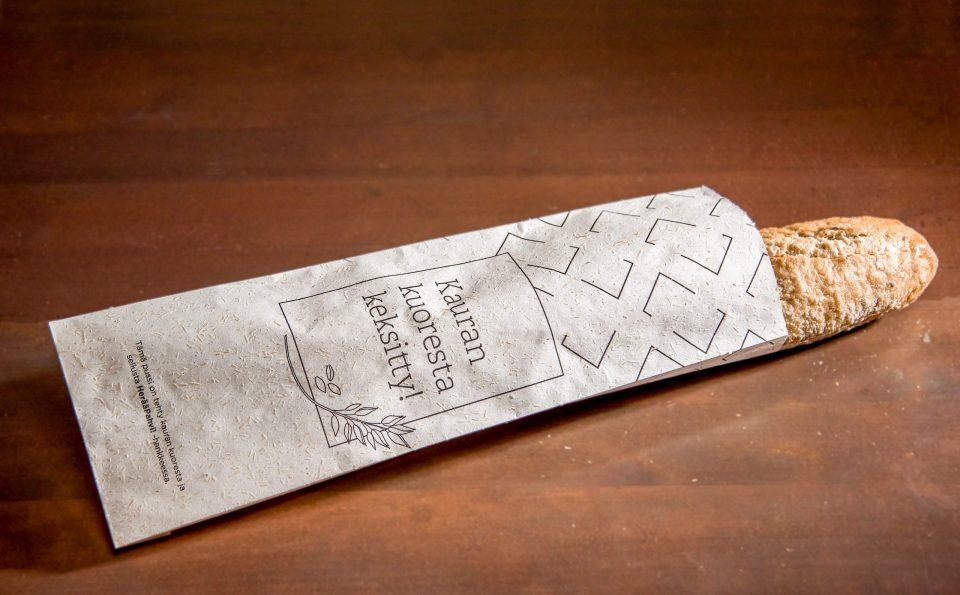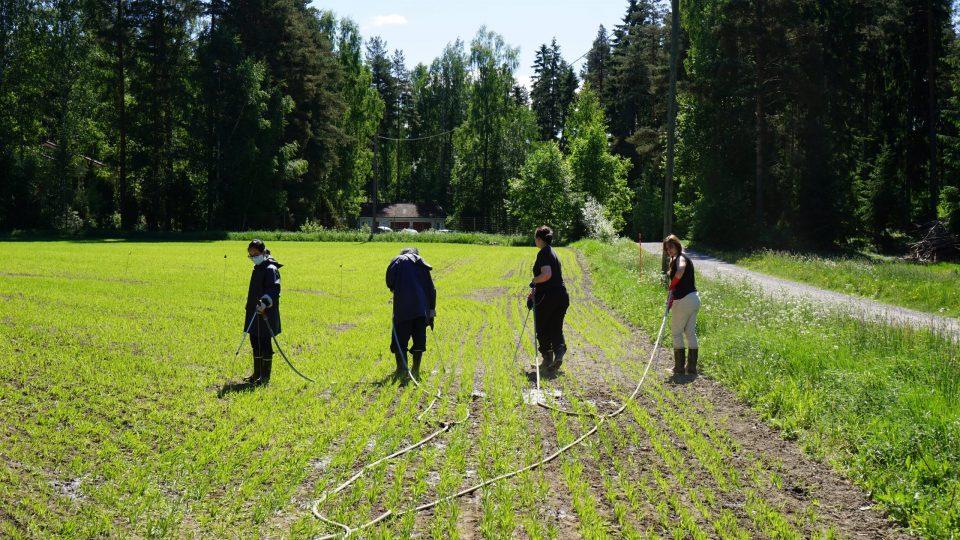
Silja Kostia, Ulla Häggblom, Erkki Kiviniemi, Mikael Lindell, Riitta Vihuri & Eeva-Liisa Viskari
New research group promoting sustainable solutions and business
Four research groups started at Tampere University of Applied Sciences (TAMK) in the beginning of February 2020. TAMK is an acknowledged actor in the research, development and innovation (RDI) activities and an attractive multidisciplinary educator with over 10 000 students and over 40 degree programmes. The Master’s degree programme in Risk Management and Circular Economy (RIMCE) is a forerunner. This is an excellent basis for the developmental actions.
Target of the “Next level circular bioeconomy actions” research group is to strengthen TAMK’s impact as a promoter in future sustainable solutions and business. It originates from the existing expertise and research projects, and meets the challenge of a multidisciplinary team sharing a common goal. In this article we describe TAMK’s research topics and achievements in circular bioeconomy, and aims and actions of the new research group. TAMK’s role in the regional innovation ecosystem is also discussed.
From table to table – research closing nutrient and material loops
No food is grown without fertilization and energy input in agriculture. Due to diminishing phosphorus reserves, nutrient recovery and reuse is essential in the future. Promising results have been achieved in terms of using, for example, source-separated urine as such, or nutrients recovered from urine, as a fertilizer. Tampere University of Applied Sciences has coordinated in 2015–2019 several research projects related to nutrient recovery and reuse (Viskari et al., 2018, Malila et al., 2019b), and therefore has a lot of experience in promoting circularity and sustainable livelihoods. The research and development also aim at raising discussion about the acceptability, safety and administrative challenges of these fertilizer products. Furthermore, different technological solutions, like a mobile nutrient-recovering toilet unit in the field use have been tested (Malila et al., 2019a).
Food production, including the whole value chain, is one of the key factors in lowering carbon emissions. Also, the source of protein in our diet has importance. Concrete outcomes of the research projects are for example the initiation of Tampere Hall roof plantations and edible park of the Lielahti Manor, in the project where urban agriculture was implemented and pilot plantations established in the city of Tampere (Asikainen et al., 2017). Use of local and seasonal food has been promoted by recipe development and piloting, with special emphasis on seasonal ingredients and local foodstuffs (Elinvoimaa lähiruoasta, 2018). In addition, new sustainable food products, menus and business models have been created to Särkänniemi area as an outcome of carbon-neutral food chains development, which is more widely described also in this journal (Heikkilä & Lindell, 2019; Heikkilä & Lindell, 2020). Together with five research partners, know-how of economically feasible insect production has been developed. Towards insect bioeconomy project, in which TAMK participated, searched for the latest know-how on biomass, that could be utilized in insect rearing systems, profitability of production, and the cornerstones of the economy, new business models, insect product development, consumer preferences, and the health and welfare effects of insect products (Vihuri & Wickman-Viitala, 2020).
Food and packaging industries aim at using sustainable packages and replacements for plastics in packaging. In Finland, oat paper is the first circular economy package application utilizing side streams of the food industry (Häggblom & Viitaharju, 2020). Other side streams like barley shells, mash, peels of carrots and potatoes are the next target of the research (Ecodesigncircle, 2020). Alongside technical development of innovative materials, an important activity has been a dialogue between creative industries and multidisciplinary student teams. This has resulted in bio-based package and service innovations commissioned by the industry (Häggblom et al., 2017). To promote low carbon bio-based society, a testing environment for biodegradability and compostability of materials and products is important. A testing environment has been built and is available for research and testing of biodegradable materials and products (PIHI, 2020).

Actions are needed to reach the next level
Frølund and coworkers have studied key elements of collaboration between universities and companies for a long time. They underline that collaboration between companies and universities is a critical driver of the innovation economy, and that even smaller, more regionally oriented companies have come to believe that universities are key ecosystem stakeholders in supporting and shaping their regional economies. However, the distributed governance of expertise at universities is recognized one of the key problems in university-industry collaboration (Frølund et al., 2018). To tackle the challenge of distributed governance, need for regular stakeholder meetings in the Campus was identified but also the need to walk off campus. Universities of applied sciences are in the core of regional innovation ecosystems, and although there is never enough communication and interaction, regular and jointly agreed meetings make stakeholder collaboration systematic.
Four types of actions were identified to increase the impact of the research and development in the field of circular economy:
- Better communication of present RDI strengths and competences
- Strengthening stakeholder relationships and analysis of their needs
- Strengthening relationships with international partners and customers
- Conceptualizing ideas based on the needs of the stakeholders.
To sum up, mapping of one’s own expertise and experts, more communication and interaction with national and international stakeholders, and development of one’s own processes to support flexible collaboration are key factors. This might look self-evident but still needs a systematic approach and resources, which are now available at TAMK.
The next level in practice
Previous projects and studies have revealed that there is a lot of unused potential in Pirkanmaa region to promote circular economy in several fields of industry (Halonen et al., 2017; Ramboll, 2016). Also, there is a lot of opportunities to develop circular economy service business, while so far the focus has been mostly on material circulation and less on services (Ramboll, 2016). Coordination of FISS (Finnish Industrial Symbiosis System) regional workshops is not yet organized in Pirkanmaa region, which is an opportunity for TAMK to take the leading role. Purpose of the workshops is to find companies and other actors in the region, which have exploitable waste and side streams to be used as a resource for new products and services. Regionally, industrial symbiosis put circular economy in practice.
Construction industry is a significant field of business in the national economy. TAMK is one of the biggest and strongest construction and civil engineering educator in Finland. For promotion of sustainable circular bioeconomy, there are already research actions, for example in monitoring and measurement of hazardous substances in construction materials, which is crucial in demolition and renovation projects, in terms of occupational and environmental health (Viskari et al., 2018, 2019). Further actions will include research and development in carbon neutral construction, promotion of wood construction and taking sustainable housing and human viewpoint into focus. New initiatives have already been mapped and cooperation with construction companies, urban development actors and cities are initiated.
Combining nutrient recycling with new nutrient recovery technologies in an urban environment, creating and initiating sustainable food systems and packaging materials, and promoting new entrepreneurship, products and business opportunities around these themes will be key drivers in the future actions of the research group. For example, in the city of Tampere the new housing area of Hiedanranta and development of Särkänniemi Theme Park sustainable food street offer extremely innovative live labs for the development.

The way forward
The research group approach is a development project as such. One of the goals is to create continuity of research topics instead of separate projects. Collecting TAMK’s circular bioeconomy projects together made existing capacity “visible”. Analysis of the content of the projects resulted in identification of “from table to table” research theme, presented in this article. Further, six different internal stakeholder groups have been identified also promoting sustainability. TAMK’s role in the regional innovation ecosystem is important not only through RDI activities but also because of the capacity of international networks and collaboration.
The aims, actions and opportunities we have described here do not correspond with the traditional research group. We have deliberately chosen the strategy with strong stakeholder involvement, both inside and outside the organization. We want to strengthen TAMK’s impact as a promoter of circular bioeconomy, which we associate with proactivity, co-creation and even crazy multidisciplinary ideas with a strong involvement of students as innovators. In our vision, solutions for challenges in the future circular society are not conventional, and that is why new multidisciplinary and multi-stakeholder platforms are needed.
Authors
Silja Kostia, Principal Lecturer, Ph.D., Tampere University of Applied Sciences, silja.kostia(at)tuni.fi
Ulla Häggblom, Principal Lecturer, Dr. Sc. (Tech.), Tampere University of Applied Sciences, ulla.haggblom(at)tuni.fi
Erkki Kiviniemi, Senior Lecturer, M.Sc. (Tech.), Tampere University of Applied Sciences, erkki.kiviniemi(at)tuni.fi
Mikael Lindell, Senior Lecturer, M.Sc. (Econ.), mikael.lindell(at)tuni.fi
Riitta Vihuri, Tampere University of Applied Sciences, Senior Lecturer, M.Sc. (Econ.), Tampere University of Applied Sciences, riitta.vihuri(at)tuni.fi
Eeva-Liisa Viskari, Impact Leader, Ph.D., Tampere University of Applied Sciences, eeva-liisa.viskari(at)tuni.fi
References
Asikainen, E., Björkman, F., Grobler, G., Haapamäki, S., Kloet, M., Mattila, A.-M., Pakula, S., Tuukkanen, K., Viskari, E.-L. (2017). Kunnioitusta raaka-ainetta kohtaan – viljeltyjä tarinoita ruokapöytiin. KIVIREKI-hankkeen julkaisu. Käymäläseura Huussi ry, Tampere. Available at: http://www.huussi.net/wp-content/uploads/2015/09/KIVIREKI_julkaisu_2017.pdf
Ecodesigncircle. (2020). Project’s www pages https://www.ecodesigncircle.eu/17-spotlight/56-heraeae-pahvi-a-cardboard-to-wake-up-finland (read 30.4.2020)
Elinvoimaa lähiruoasta. (2018). Lähiruokareseptejä. Elinvoimaa lähiruoasta – kumppanuudet lähiruoan hankinnoissa –hanke. Available at: https://www.virrat.fi/client/virrat/userfiles/elinvoimaa-lahiruoasta-valmis-versio-002.pdf
Frølund, L., Murray, F. & Riedel, M. (2018). Developing Successful Strategic Partnerships With Universities. MIT Sloan Management Review. Magazine Winter 2018, Issue Research Feature.
Halonen, E., Alakerttula, J., Lanz, M., & Seppänen, M. (2017). Pirkanmaan kiertotalouden innovaatiotoiminnan nykytila. Pirkanmaan liitto. Available: https://tutcris.tut.fi/portal/files/13175134/Pirkanmaan_liiton_selvityksi_2017_Pirkanmaan_kiertotalouden_innovaatiotoiminnan_nykytila_p_2.pdf
Heikkilä, T. & Lindell, M. (2019). Kestävän matkailun hub – Uusi Särkänniemi. Teoksessa A. Mäntysaari, A. Törn-Laapio & H. Siltanen (toim.), Yhteiskehittämisestä kilpailuetua matkailu- ja ravitsemisalalla. Jyväskylän ammattikorkeakoulun julkaisuja 270.
Heikkilä, T. & Lindell, M. (2020). Kestävää liiketoimintaa ruokapalveluissa. UAS Journal 2/2020.
Häggblom, U., Damski, V. & Vepsäläinen, A. (2017). Hiilinielu Design Studio – Muotoilu kohtaa biotalouden. Tampereen ammattikorkeakoulun julkaisuja B:96. Available: http://julkaisut.tamk.fi/PDF-tiedostot-web/B/96-Hiilinielu-Design-Studio.pdf
Malila, R., Viskari, E.-L., Kallio, J. (2019a). Virtsan ravinteet kiertoon – MORTTI -hankkeen loppuraportti. Suomen ympäristökeskuksen raportteja 49/2019. ISBN 978-952-11-5107-1, ISSN 1796-1726. Available: http://hdl.handle.net/10138/307654
Malila, R., Viskari, E.-L., Lehtoranta, S. (2019b). The role of source separation in nutrient recovery – comparison of alternative wastewater treatment systems. Journal of Cleaner Production. 219: 350-358. 10 February 2019. https://doi.org/10.1016/j.jclepro.2019.02.024
PIHI. (2020). Project’s www-pages. https://www.tuni.fi/fi/tutkimus/pihi-pirkanmaan-vahahiiliset-kalvoratkaisut (read 30.4.2020)
Ramboll. (2016). Bio- ja kiertotalouden hankkeet, osaaminen ja haasteet Tampereen kaupunkiseudulla ja Pirkanmaalla. End-of-project report. Available: http://www.pirkanmaa.fi/wp-content/uploads/Bio-ja-kiertotalousselvitys_Loppuraportti_21_09_16_logoilla.pdf
Vihuri, R. & Wickman-Viitala, T. (2020). Hyönteistoimialan liiketoiminnan kehittäminen. TAMKjournal 24.4.2020. Available: http://tamkjournal.tamk.fi/hyonteistoimialan-liiketoiminnan-kehittaminen/
Viskari, E.-L., Grobler, G., Karimäki, K., Gorbatova, A., Vilpas, R. & Lehtoranta, S. (2018). Nitrogen Recovery With Source Separation of Human Urine—Preliminary Results of Its Fertiliser Potential and Use in Agriculture. Frontiers in Sustainable Food Systems. 2:1-14, 28 June 2018. https://doi.org/10.3389/fsufs.2018.00032
Viskari, E.-L., Kauranen, H., Nieminen, M., Nippala, E., Tuominen, E.-L. & Honkala, I. (2018). Palosuoja-aine HBCD rakennuseristeissä ja pakkausmateriaaleissa ‒ esiintyminen, tunnistaminen ja turvallinen käsittely. Tampereen ammattikorkeakoulun julkaisuja. Sarja B. Raportteja 111. Tampere 2018. Available: https://www.tamk.fi/-/palosuoja-aine-hbcd-rakennuseristeissa-ja-pakkausmateriaaleissa-esiintyminen-tunnistaminen-ja-turvallinen-kasittely
Viskari, E.-L., Kauranen, H., Nieminen, M., Nippala, E., Tuominen, E.-L. & Honkala, I. (2019). Palonsuoja-aine on kierrättäjän pulma. Uusiouutiset 2/2019, 36–37.



